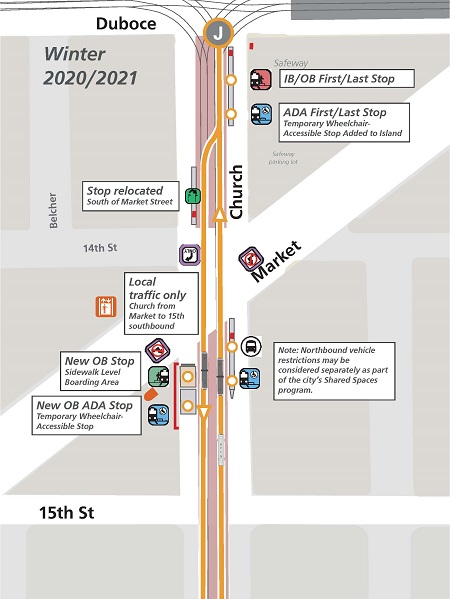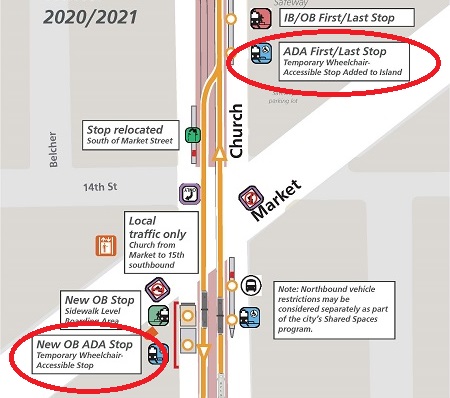Project Introduction
Expanding Subway Capacity
As traffic congestion returns, the SFMTA is working to protect San Franciscans who continue to rely on Muni to get to work and essential appointments during this pandemic. If just a fraction of the people riding transit before the crisis begin driving alone, traffic congestion will be so severe that it could paralyze the city’s economic recovery. Without action, transit-dependent San Franciscans will bear the costs of traffic congestion, like an increased risk of exposure to COVID-19 on slower, more crowded buses and trains. Putting Metro rail back in service will free up buses currently in use for the L, M, N and T to serve additional routes and improve frequencies systemwide. The J Church, which was suspended along with all other Muni Metro lines in March, returned on December 19, 2020 (as a surface-only route).
As rail service is restored following its temporary suspension under the Core Service Plan, the SFMTA will gradually increase capacity in the subway by readjusting which train lines enter the tunnels, beginning in Spring 2021. The J Church was chosen to remain out of the Muni Metro subway because of surface-level route constraints which limit the line to one car trains. By turning back the J Church before it enters the subway we will ensure that more two-car and three-car trains are able to maximize the capacity of our subway system. In addition, traveling a shorter surface route saves travel time for the J Church, allowing for increased frequency and capacity. This helps support social distancing on-board.
Accessibility and Safety Improvements
To assist Muni customers transferring between the J Church and Market Street transportation for the duration of this temporary service plan, we implemented temporary transfer improvements on Church Street from 15th Street to Duboce Avenue.
Through traffic was prohibited on Church Street between Market and 15th streets and the curb lane on west side of Church Street was designated as a pedestrian safety zone with no vehicular traffic.
Local traffic is still permitted, such as delivery services, commercial loading, and resident access.
Duboce Avenue now serves as the final inbound stop for the temporary J Church surface-only route. To support this:
(1) a new temporary accessible platform was added to the boarding island on Church Street south of Duboce Avenue next to Safeway
(2) a new temporary boarding zone and accessible platform were added on Church Street south of Market to serve as an outbound stop (replacing the stop north of Market Street, which is not wheelchair-accessible)

Safety and accessibility highlights - Winter 2020/2021

The SFMTA may adjust the precise configuration in this area over time based on detailed design and engineering to enhance accessibility and transit efficiency. The closure of the northbound travel lane on Church Street between 15th and Market streets is currently a part of the citywide Shared Spaces program and is not a part of this temporary transfer project.
Community Meeting and Public Comment
The J Transfer Improvements project held a public hearing on Saturday, July 25, 2020, at 11:00 AM for proposed street changes at the intersection of Church and Market Streets.
A recording of that meeting is available on this web page. All comments were reviewed by project staff and entered into the public record. These changes have been authorized by order of the City Traffic Engineer and were reviewed at the SFMTA Board of Directors Meeting on September 15th, allong with additional public comments.
Implementation and Sunset Date
The transit zone is subject to removal after the Mayor's emergency order is lifted, unless there is a public process to make the transit zone permanent (see current project page for details)
Outreach and Evaluation
The urgent nature of this emergency calls for putting temporary measures into place immediately. This approach allows the city to respond quickly to protect public health and support economic recovery while we work with the community to evaluate and adjust the design of this project in real time. Areas of evaluation will include:
- Health and safety benefits
- Economic health
- Neighborhood impacts and equity
- Transit performance
- Traffic safety
Community-based organizations, stakeholders and neighbors will be involved in shaping the process for evaluating and adjusting the design of this project. Based on public feedback and ongoing, on-the-ground data monitoring of the transfer zone changes, we can adjust our operations meet the needs of the community and Muni customers. Both qualitative and quantitative data will be collected after implementation and will inform any changes needed and whether permanent approval of the transfer zone should be pursued.